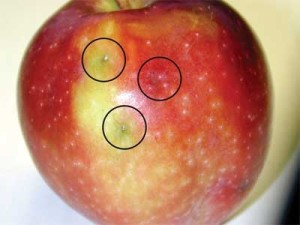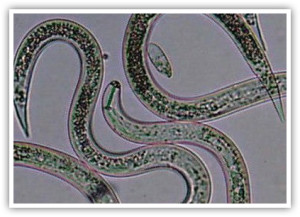How’s Your Apples?
or
Battling the Apple Maggot
Fall is the time of year that many unfortunate home gardeners find out they have an apple maggot problem.
It is unfortunate not only that they have a destructive pest problem to deal with, but also because they have lost out on a season’s worth of apples! The good news is both pests can be stopped for next year with a little work this fall and a little bit of vigilance next spring.
How It Happens…
In the summer months, July through October, fruit flies are attracted to maturing fruit, mostly apples but sometimes pears, plums, apricot, and cherries. The female fruit fly punctures the fruit and inserts eggs, up to 300, during her 30 day life span.
The first sign of a problem is dimpling in the fruit. In 3-7 days these eggs hatch into maggots that tunnel through the apple, leaving a brown trail of damaged fruit. The fruit then rots and drops from the tree. The maggot enters a larvae stage that exits the fruit and hibernates all winter in the soil under the tree.How To Protect Your Fruit!
Step 1. Apply Beneficial Nematodes to the area around the trees.
Beneficial Nematodes are a microscopic worm that lives below the surface of the soil and attack over 250 different types of pests without bothering plants, pets, or people. The Nematode hunts its prey by by sensing vibration. Once found, they enter the pest through a body opening or by boring an opening.
Once inside the pest, the Nematode releases a bacteria that kills the host within 48 hours. It will then feed on the dead host, reproduce, and exit to look for more prey. As winter approaches, the Nematodes travel deeper into the soil to protect themselves from freezing temperatures, going into a semi dormant stage. As the soil warms in the spring, the Nematodes become active again and attack the pests they didn’t kill last fall. A fall application gives the home gardener a bigger window of opportunity to stop the apple maggot before they cause damage to apples or any other similar fruit crop.Step 2. Clean up all the rotted fruit and leaves around the base of the trees.
Larvae are coming from this refuse, so clean up often around your trees, and you will be stopping more larvae before they enter the soil.
Do not add this to your compost pile or you will be re-introducing the pest.
Step 3. Trap the fruit flies.
Use sticky yellow traps or apple maggot lures to monitor your trees after the flowers have dropped from the tree. The fruit flies are attracted to the yellow color and scent on the traps, land, and become stuck. There are several types of traps available at most garden centers. Some are red spheres with an adhesive coating to look like a ripe apple. Some have pheromones to attract by smell and all seem to work well.
A simple home made trap is using a gallon milk jug, cut a hole at the top and fill with:
1 cup sugar
1 cup apple cider vinegar
2 banana peels
Fill partially with water,hang the jug in the tree and the fruit flies are attracted to the scent from the liquid inside, enter and drown.
We hope this helps you have healthy, productive fruit harvests!



